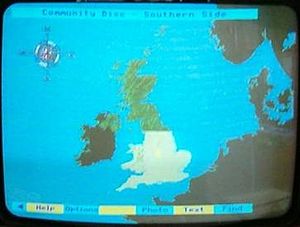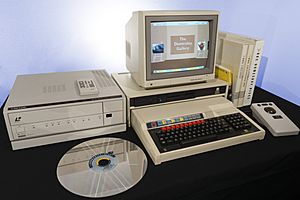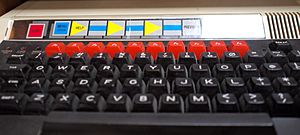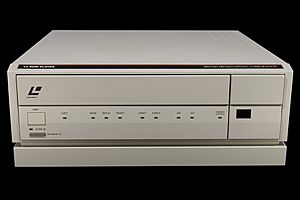BBC Domesday Project facts for kids
The BBC Domesday Project was a special project created by the BBC and other companies like Acorn Computers and Philips. It was made in 1986 to celebrate 900 years since the first Domesday Book. That original book was an old census (a count of people and things) from the 11th century in England.
This new Domesday Project was a huge multimedia collection. It was put together between 1984 and 1986. It included a new "survey" of the United Kingdom. Many people, especially school children, wrote about their local areas. They wrote about geography, history, or daily life. This information was linked with maps, photos, facts, videos, and even "virtual walks." Over a million people helped with the project, including kids from more than 9,000 schools!
Contents
Why the Project Was Made
The main idea was for schools to be a big part of gathering information. The plan was for about 10,000 schools and a million children to join in. Each school was given a specific area to focus on. Students and local people would collect information. Schools would then use computers to organize it.
They filled out questionnaires about their area's geography, services, and how land was used. Students and others could also write about their local area in their own words. They shared what was important to them.
Experts believed that handling data helps children learn. It teaches them to think critically. When computers store and sort data, kids can focus on understanding what the data means.
One person who reviewed the system said:
The concept behind Domesday is very far reaching, since for the first time large quantities of images and data can be held together. For publishers and knowledge workers, the media for communication will never be quite the same. And this really is just the start.
– Pip Forer
This meant the project was a big step forward for how information could be shared.
How the Information Was Stored
The Domesday Project was stored on special discs called LaserDiscs. These discs used a format called LV-ROM. They could hold both video and still pictures, plus digital information. Each side of a disc had 300 MB of storage space. The whole project was planned to hold a lot of pictures and text pages.
The BBC Domesday team gathered and organized all the data and images. The discs were then made and tested by the Philips factory in England.
To view the discs, you needed a special computer system. This included a BBC Master AIV computer. It was connected to a Philips VP415 LaserVision laserdisc player. Users controlled the system with the computer's keyboard and a trackball. This setup allowed the computer to control the laserdisc player and access the stored information.
The project was split across two laserdiscs:
- The Community Disc held personal stories about life in Britain. You could explore it using a map of Britain. The country was divided into small blocks. Each block could have photos and short stories about that area.
- The National Disc had more varied information. This included facts from the 1981 census and professional photos. It also had "virtual reality" tours of famous places. You could explore some of the content by walking through a virtual art gallery. You could click on pictures or go through doors to enter the virtual tours.
Saving the Project for the Future

By 2002, people worried that the Domesday discs might become unreadable. The special computers and disc players needed to read them were becoming very rare. Also, the images were stored in an old way, as single video frames. This was before modern image formats like JPEG existed.
CAMiLEON Project
Later, a project called CAMiLEON found a way to read the discs. They used emulation techniques. This means they made new computers act like the old ones. They copied the text and data files from the discs to a Linux computer. The images, which were video frames, were digitized (turned into digital files). This took up a lot of storage space. They then used a modified computer emulator to access the saved data.
Digitizing Videotapes
Another team found the original videotapes used to create the project. They digitized these tapes. This means they converted them into digital files.
Domesday 1986
A version of one of the discs was made to run on Windows computers. This version was available online for a while. It used images from the digitized videotapes.
Domesday Reloaded
In 2011, a team at BBC Learning put much of the Community disc data online. This website, called BBC Domesday Reloaded, had about 25,000 images. It was online until 2018.
Domesday86
The Domesday86 project is working to save the technologies used to access Domesday. They want to make it possible to use the Domesday system without needing the rare original hardware. They are creating new hardware and software for this.
Museum Efforts
The Centre for Computing History has also worked to save the Domesday Project data. They have made it available online. They also have a working Domesday system on display for the public. The National Museum of Computing also used to have working Domesday systems.
Language Challenges
At first, the Domesday Project only allowed text to be entered in English. This caused problems for Welsh schools. In some areas, both English and Welsh were spoken. Welsh schools felt it was unfair to ask children to write about their local area in a foreign language.
The BBC eventually allowed some Welsh text. But each Welsh page had to have an English translation. This meant Welsh schools had less space for their content. Some schools even boycotted (refused to join) the project because of this. There were also concerns that the survey questions were more suited for city areas than rural ones.
Even though many schools were interested, most were in cities. This left "big gaps of knowledge" in rural areas. So, the Domesday Project team had to ask other groups for help. These included the Women's Institutes, The Scout Association, and The Guide Association.
Copyright Issues
Saving the Domesday Project also involves complicated copyright issues. Many people contributed to the project. This means there are copyrights from about a million different people. Also, the technologies used have their own copyrights. It is thought that the Domesday Project might not be completely free of copyright rules until at least 2090.
Interactive Video Beyond Domesday
The BBC Master-based system used for Domesday was also meant for other interactive video uses. It could work with computer languages like BASIC. People thought this technology could be used in many areas, not just education.
BBC Enterprises and Virgin released other interactive video discs for learning. For example, the Ecodisc from BBC Enterprises was an ecological simulation. It was designed to help students learn about nature. Another disc, Countryside, provided facts about farming. The Volcanoes disc featured videos of eruptions and cool computer graphics.
Other companies also made interactive learning tools. Some used laserdiscs, while others used videotapes. These systems aimed to make learning more engaging than just reading books.
However, Acorn's success with interactive video was affected by their financial problems. The Domesday system was quite expensive. By early 1988, fewer than 2,000 Domesday systems had been sold.
Newer Acorn computers were also used with laserdisc systems. For example, one system combined a BBC A3000 computer with a laserdisc player. It came with discs for secondary schools. Other software also supported laserdisc players for educational uses.
Images for kids







